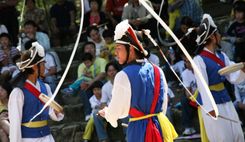23. Discover glorious Gyeongbokgung Palace
The glorious palace of Gyeongbokgung is, with good reason, the most popular tourist sight in the city, and a focal point of the country as a whole.
The place is absorbing, and strolling the dusty paths between its delicate tile-roofed buildings is one of Seoul's most enjoyable experiences.
Gyeongbokgung was ground zero for Seoul’s emergence as a place of power, having been built to house the royal family of the embryonic Joseon dynasty, shortly after they transferred their capital here in 1392.
While the complex has witnessed fires, repeated destruction and even a royal assassination, careful reconstruction means that the regal atmosphere of old is still palpable, aided no end by the suitably majestic crags of Bugaksan to the north.
A large historical complex with excellent on-site museums, visiting this stunner can easily eat up the best part of a day.
Editor's tip: time your visit to coincide with the colourful changing of the guard ceremonies.






























